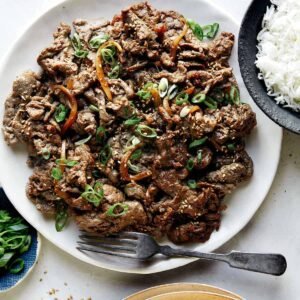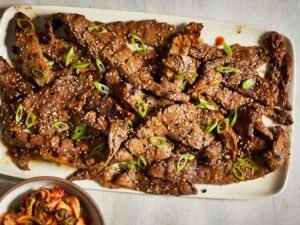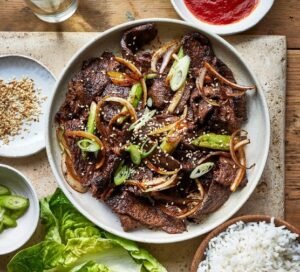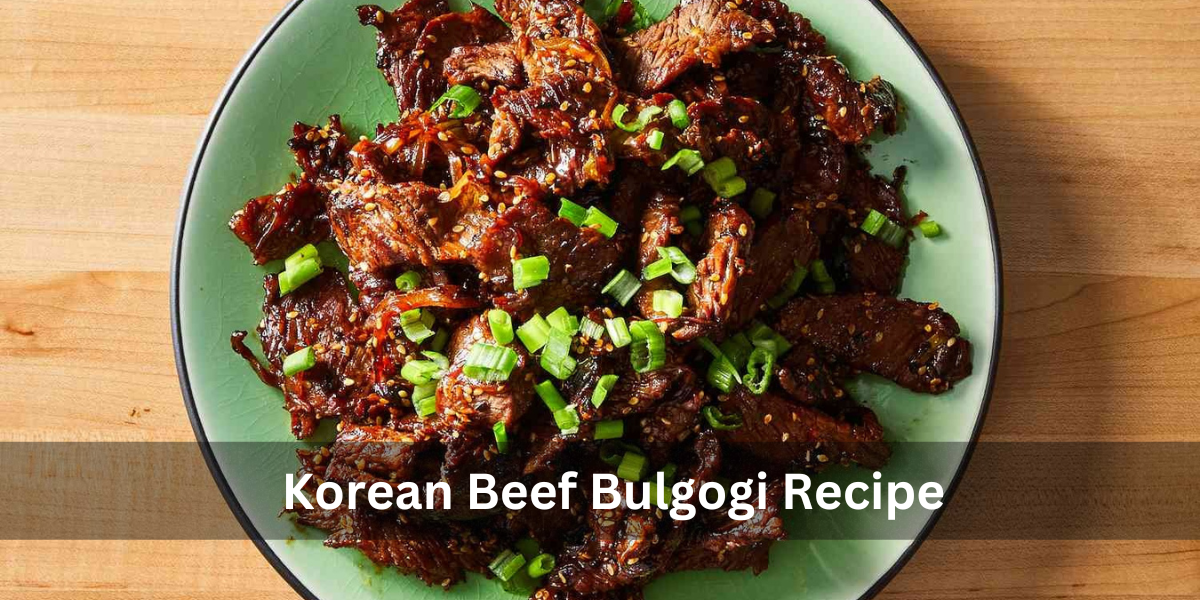This simple recipe is ideal for preparing Beef Bulgogi, a wonderful Korean dish. Using simple products and methods, you can prepare a Korean restaurant-quality lunch at home in 30 minutes! Try this recipe; you’ll love it!
Bulgogi: Then and Now…
To be honest, I don’t remember eating much bulgogi when I was growing up in Korea. We only ate bulgogi on exceptional occasions and at large family gatherings. Meat was expensive, and bulgogi was considered a gourmet dish among Koreans.

I am delighted we relocated to the States because it allowed me to eat more bulgogi! My children now eat bulgogi on a regular basis, which is quite different from my experience. I’m also delighted that bulgogi has become a popular Asian beef dish all across the world! Everyone can now enjoy this delectable cuisine whenever and wherever they want!
What is bulgogi?
Bulgogi is an extremely popular Korean meal. The word has a literal definition, with bul meaning fire and gogi meaning meat, resulting in fire meat. The most popular is beef-based and sweet. However, there is also a pork and spicy beef variation. Bulgogi meat is often thinly sliced and marinated in a savory-sweet sauce. Once cooked, you can serve it with rice and other Korean side dishes. Many Koreans have traditionally enjoyed it as a party snack.
How does Korean beef bulgogi taste like?
This beef meal boasts a good balance of salty and sweet flavors. The combination of fresh aromatics, fruit, and rice wine creates a lovely harmony. Creating a flavorful marinade is the key to making excellent bulgogi!!
Can toddlers/small children eat bulgogi?
Toddlers and children enjoy bulgogi because of its softness and sweet flavors. Korean children enjoy them with bulgogi wrapped in toasted seaweed and rice. Just make sure the meat is cut into tiny pieces.
What kind of meat should you use for bulgogi?
Bulgogi beef: Thinly cut beef ribeye, sirloin, or flank steak works as well.
This recipe calls for beef bulgogi. The best option is to get thinly sliced beef bulgogi from Asian stores. If you can’t find pre-sliced beef, buy tender meats like ribeye, top sirloin, or flank and finely slice them yourself.
Is it necessary to soak bulgogi meat in water?
Personally, I prefer to wash all my meats. However, because bulgogi is more tender than other meats, I only keep it in cold water for a brief period of time. Then I carefully place the meat on the strainer until it is ready to use. You’ll see the red cloudy watercolor.
This procedure also removes gamey flavors and harshness from meat when cooked. However, I do not recommend soaking bulgogi meat for a lengthy time. You don’t want to remove the beef flavor!
Can you make the beef bulgogi marinade ahead of time?
This is an excellent idea. Making the sauce a day ahead will result in a much deeper flavor! I wish I had the time to complete this! If you do make it, you may make a larger quantity and store it in the fridge for two weeks.

How long should I marinade the beef?
I’ve done both techniques, marinating the steak for 15 minutes to overnight. If you do marinate overnight, I recommend making the sauce less salty. (Adding a little water to the sauce will suffice.)
I also discovered that when you marinade the meat overnight, the texture changes slightly. The pear will make the meat more soft. It’s up to personal opinion, however I prefer to marinade and cook my meat on the same day.
Where do you store the marinated meat?
When I’m in a rush, I marinate my bulgogi in a tight zip lock bag before putting it in the fridge for half to an hour. I know some people marinate the meat overnight, but since the meat is so thin, it’s not really essential.
Beef Bulgogi
You can also use glass or metal bowls and cover them in plastic before storing in the refrigerator. Any airtight container will suffice, effectively removing all air. This method, the seasonings will thoroughly marinade the meat.
How should you cook Korean beef bulgogi?
Pro tip 1: There are a few different ways to prepare marinated beef bulgogi. The simplest way to cook at home is with a stovetop and a nonstick skillet. Rib eye is already fatty, so you don’t need much oil. Cook in tiny quantities over high heat to achieve that lovely smoky flavor!
Pro tip 2: If you want that caramelized look, cook in tiny quantities in a single layer over high heat. Steel pans are not advised since bulgogi sticks to them like crazy. If you do decide to use a cast-iron skillet, I recommend oiling it first and keeping an eye on the fire level to avoid burning. Use tongs or chopsticks to swiftly flip the meat and prevent it from sticking.
Pro tip 3: If you prefer your bulgogi with extra sauce at the end, cook it in one batch over high heat. Then cook the meat until just done. Skip the caramelizing and enjoy plenty of sauce with your rice.

Pro tip 4: Next comes the portable BBQ skillet method. These are primarily sold in Asian markets. They are dome-shaped with an edge where fat is drained. This is ideal if you own a portable burner. We use this for gatherings and can grill the meat on our deck table.
Finally, the outdoor barbecue. I recommend cooking bulgogi on foil or a thin sheet pan. Otherwise, you will lose a significant amount of meat between the grills!
Do you use oil when cooking bulgogi?
If you wish to lightly oil the pan, I recommend using a neutral oil such as maize oil, canola oil, or rice bran oil. I do not advocate using olive oil because it has a strong flavor. Sesame oil should not be used to cook, but rather in the marinade or poured over the meat once it has been cooked.
Why do you drizzle the honey at the end?
This is something I started doing once I got into food photography. I noticed that when my bulgogi cooled on the table, it lost its sheen. Even after an hour, sprinkled with honey, the meat looked even more delicious. You can also use sesame oil to achieve this effect.
Can apple be used instead of pear in the marinade?
If you can’t get a Korean pear, I recommend using the bosc pear and apple last. I believe that pear has a superior technique of tenderizing meat than apples. If you visit Korean markets, you might be able to find grated pear sauce packages.
Can you include vegetables to the bulgogi recipe?
You don’t have to, but vegetables pair well with bulgogi. I like my vegetables crunchy, so I’ll add them near the end of the meat cooking time. To keep it visually appealing, I recommend julienned vegetables. Furthermore, it is easier to pick up with chopsticks. The vegetables that go well with bulgogi are:
Vegetables: carrots, mushrooms
Ingredients include onion and red pepper.
What do you usually serve with bulgogi?
Bulgogi pairs nicely with a variety of meals, although it is often served with white short grain rice, kimchi, and side dishes. If you want to construct a Korean BBQ restaurant-style dinner. Serve with fresh lettuce leaves, cucumber, peppers, and flavorful sauces like as samjang or gochujang. You can prepare lettuce wraps that your entire family will appreciate and have fun with!
Ingredients
- 1.9 lbs thinly sliced bulgogi beef rib-eye
- ⅓ cup Korean soy sauce
- 3 Tbsp sugar
- ⅛ tsp black pepper
- 1½ Tbsp sesame oil
Ingredients to blend:
- 2 Tbsp mirin
- ¼ small onion
- ¼ Korean pear
- 6 garlic cloves
- 2-3 Tbsp water
Garnish
- 1 Tbsp honey
- ½ tsp sesame seeds
- 1 stalk green onion chop
optional
- ¾ small onion sliced
Instructions
-
Soak meat in cold water for about 3mins. Swoosh gently and set on strainer for 5mins.
-
Combine blending ingredients, then blend until smooth. Add to it, soy sauce, sugar and black pepper. Stir well and taste. Pour sesame oil and do a final stir.
-
Into a gallon size zip lock bag, add meat then the marinade. Seal and gently message the meat for one minute. Set aside in fridge for 10-15mins.
-
Heat a non-stick skillet on high heat. Using a tongue, drop a small batch of bulgogi into the pan. Enough to cover one layer. Cook for 4-5mins or until golden brown on both sides. Cut meat if needed. Cook the rest of the meat in small batches. (optional: add sliced onion)
-
Serve on a plate. Drizzle with honey, sesame seeds and chopped green onion. Enjoy with rice and vegetables!
Tips:
- Meat Selection: Ribeye or sirloin are preferred for their tenderness and flavor, but you can also use other cuts like flank steak or brisket.
- Slicing the Beef: Freezing the beef for about 30 minutes to an hour will firm it up, making it easier to slice thinly.
- Marinade Time: The longer you marinate, the more flavorful and tender the beef will be.
- Cooking Method: While pan-frying is common, you can also grill the beef over a barbecue for a smoky flavor.
Korean Beef Bulgogi Recipe FAQ
Here are some frequently asked questions about making and enjoying Korean Beef Bulgogi:
1. What cut of beef is best for bulgogi?
- Answer: Ribeye and sirloin are the most commonly used cuts due to their tenderness and marbling. However, you can also use other cuts like flank steak or brisket if sliced very thinly.
2. How thin should the beef be sliced?
- Answer: The beef should be sliced very thinly, about 1/8 inch thick. Partially freezing the meat for about 30 minutes can make it easier to slice thinly.
3. Do I have to use Asian pear in the marinade?
- Answer: While Asian pear is traditionally used for its tenderizing properties and natural sweetness, you can substitute it with a regular pear, apple, or even omit it. The enzymes in the pear help to tenderize the meat.
4. How long should I marinate the beef?
- Answer: It’s best to marinate the beef for at least 30 minutes, but 2-4 hours is ideal for better flavor. You can also marinate it overnight in the refrigerator for maximum flavor.
5. Can I cook bulgogi on a grill?
- Answer: Yes, grilling bulgogi is a popular method. You can use a barbecue grill or a grill pan. Make sure to cook the meat over medium-high heat and avoid overcooking to keep it tender.
6. What vegetables can I add to bulgogi?
- Answer: Common vegetables include onions, carrots, zucchini, and mushrooms (shiitake or button mushrooms work well). These add texture and flavor to the dish.
7. Is there a vegetarian version of bulgogi?
- Answer: Yes, you can make a vegetarian version using tofu, mushrooms, or seitan. The marinade can be used in the same way to flavor these ingredients.
8. How do I serve bulgogi?
- Answer: Bulgogi is typically served with steamed rice and side dishes like kimchi and pickled radish. It can also be enjoyed with lettuce leaves for wrapping, along with ssamjang (a Korean dipping sauce).
9. Can I make bulgogi ahead of time?
- Answer: Yes, you can marinate the beef and keep it in the refrigerator for up to 24 hours. Cooked bulgogi can also be stored in the refrigerator for a few days and reheated.
10. What can I use if I don’t have sesame oil or sesame seeds?
- Answer: While sesame oil and seeds add a distinct flavor, you can substitute with other oils like olive oil or omit the seeds if necessary. The dish will still be flavorful but slightly different.
11. Is bulgogi supposed to be sweet?
- Answer: Bulgogi has a balance of sweet and savory flavors. The sugar and honey in the marinade contribute to the sweetness, which complements the savory soy sauce and the slight spice from the garlic and pepper.
12. Can I freeze bulgogi?
- Answer: Yes, you can freeze the marinated beef before cooking. Place the beef and marinade in a freezer-safe bag, remove as much air as possible, and freeze. Thaw in the refrigerator before cooking. Cooked bulgogi can also be frozen and reheated, though it might lose some of its texture.
ALSO READ: NABAK KIMCHI (WATER KIMCHI)
